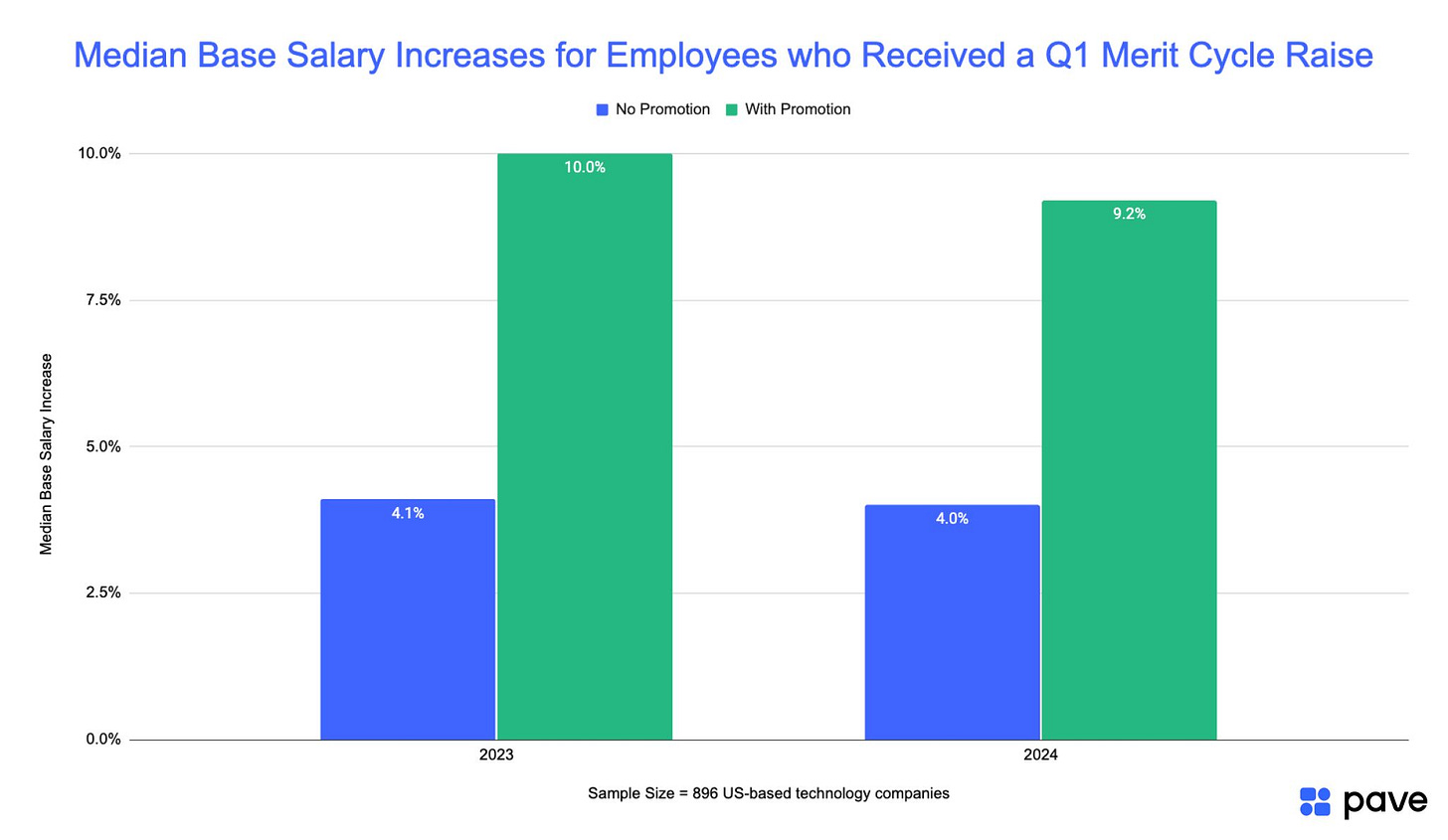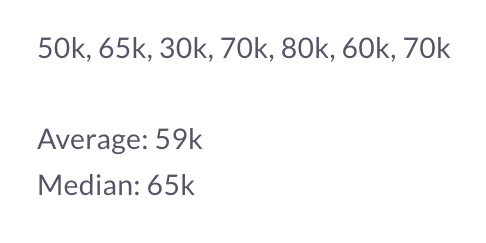What "market rate salary" really means and where to find salary benchmarks
A complete breakdown of how companies benchmark salaries and determine your package, and a list of places where you can find tech salaries.
TL;DR: Salary benchmarks should be discussed within the context of the same jobs, levels, locations, industries. Median and percentiles better describe how high or low numbers are. Tech workers can expect 4-10% raise every comp review cycle.
There are often 2 scenarios where you might need to consult what the so-called “market rate salaries” are:
When you’re looking for a new job and need to talk about the offer;
When you’re speaking to your employer about a potential pay raise.
In both of these scenarios, as employees and jobseekers we want to make sure we’re not underpaid, but also we don’t want to name a number too high that would deter the employers from giving us the offer.
Having worked for a compensation benchmarking tool Figures.hr as a product manager, I talked to companies every week about salary decisions and what fair compensation means. However, companies exist to make money, and most are only incentivized to pay employees well to use their talent.
Therefore I believe that the best way to ensure we’re paid fairly is for us individuals to be more educated on what compensation packages consist of, how they are often compared, and how to best challenge companies on their comp decisions in these negotiations.
What’s your goal?
We want to understand compensation because we want to be paid well. But this can mean very different things to different people. In my job search coaching experience, there are 2 types of goals when negotiating compensation:
I want to be paid as much as possible;
I want to be paid a reasonable salary that can help support my life and not be underpaid compared to my peers.
It helps to understand your personal goal before starting to research salary numbers, because this determines which numbers you need to look at. Want to get paid as high as possible? Look for salary numbers in those jobs, industries, companies and regions where people are most highly paid and see if you’d like to move to those roles. Want to be paid a reasonable amount in your job or field? Look for salary numbers in your specific field and region. Finding salary numbers in very high paying roles when you’re not interested in working those roles is not constructive to your potential salary negotiation conversation.
Salary benchmarking 101
Now you might have a rough idea of why it’s important to be intentional about your compensation research. So how do we understand what a fair compensation is? What are companies talking about when they say they offer “market rate salary” on their job descriptions?
HR teams usually see 4 factors having the biggest impact on compensation:
Job
Level
Location
Company industry
Job
As you know, the job itself has a big impact on its compensation. Companies attribute different values to different jobs, and the variation can be especially large in the tech industry. When an HR team decides how much they pay someone doing each job, they also often see how much the same job is paid in other companies to justify their decision. (Although why should an engineer that builds apps make 5x a primary school teacher does? Are they 5x more valuable to society? With companies like Feeld that pays everyone the same $80k I would like to imagine what a more equal world could look like.)
If an HR team cannot find salary numbers for your specific job, they might use benchmarks for a job that’s similar, e.g. using project manager benchmarks when your role is program manager. If your role is atypical or combines responsibilities from different jobs, they might get the data from multiple jobs.
Level
Generally, levels are attributed to people working the same job but have different scope of responsibilities, experience or knowledge that might differentiate the value they bring according to the company. It’s also a way to incentivize employees to stay in the company for longer when there’s a ladder to climb.
Job titles sometimes come with a hint to their level, e.g. prefixes like junior, mid-level, senior, head of, director, VP and so on. Larger companies might have more complicated leveling systems that use a letter-number combination, like IC1 (individual contributor level 1) or SDE3 (software development engineer level 3). This is an example of a leveling framework for a small to mid-sized tech company.
What’s important to know is that there is no universal leveling standard. Leveling frameworks can vary significantly depending on the company’s size, business model, organizational chart and just their general HR philosophy. Uber has a bigger software engineering team to cater to their millions of users, therefore needs a larger leveling framework, as opposed to a small web development agency that might just have a few levels.
This means levels don’t translate easily. A senior product designer at one company could be mid-level at another company (another reason why I don’t recommend writing “junior” on your CV — you could really be underselling yourself). A director of sales at one place could be VP of sales at another company.
Location
The same job at the same job in different countries can be paid very differently. Even within the same country but in different cities there could be a big gap, especially in countries where some cities have a significantly higher cost of living, e.g. Paris vs the rest of France, tier 1 US cities like San Francisco vs tier 3 cities like Phoenix, Arizona.
Typically, HR teams want to pay employees salaries that correspond to what’s more common in the company’s location. But as more and more companies employ a globally distributed workforce, they might use one of these 3 location strategies:
Pay same rates regardless of location (“location independent”) — this means that the company will pay everyone San Francisco salaries even if someone is based in Lima, Peru. Buffer is probably the most well-known example using this strategy and you can view all of their team’s salaries and how they were calculated here.
Pay everyone according to salaries in their country’s capital — if employees are based in a small city or town it’s often hard to get salary benchmarks for that city, so a company might choose to pay everyone the rates of the capital city. At Figures, we had employees based in Annecy and Marseille in France, they were paid Paris-rates; others based in Limerick, Ireland and Cambridge, UK were paid respectively Dublin and London rates.
Pay everyone according to salaries in their own cities — this option would mean salaries can best match local costs of living for employees, but not always easy to implement. If someone lives in a 1000 population town there could be little to no salary data for their type of job and level.
Company industry
Take the same job, at same level, in same location, but at two different companies with different industries, their compensation could also vary. This could be due to the company’s business model, profits, sources of funding. This example from the US Bureau of Labor Statistics shows that “producers and directors in advertising, public relations, and related services had a median annual wage nearly twice that of producers and directors in theater companies and dinner theaters, $90,690 a year compared with $49,280”.
Average? Median? Percentiles
Say that we’ve done our research or our company has presented us with some salary numbers in a negotiation, and we’re seeing some numbers. Would it make sense to take the average of the numbers to say that’s the market rate?
As you might have learned in math class, the average number might not be representative for the data set. If there are very low or very high numbers then the average could be skewed. Imagine 7 people are paid the following salaries as below, the average is 6k lower than the median.
The median might better represent the dataset, but it’s harder to expect the median to change unless the market shifts drastically or if we change jobs/level/location/industry. So how can we get paid better?
Compensation benchmarking typically works with percentiles, which is another way to compare where a number is compares to other numbers in the same dataset. In this context, companies typically use the 25th, 50th (same as median), and 75th percentiles. If a company says they pay “market rate”, I would expect them to pay at the 50th percentile. But if they say they pay “above market rate”, I would expect them to pay at the 60th, 70th percentiles or higher.
Sometimes, going up a level will give you a bigger salary increase than going up in percentiles. Charlie Franklin, founder of compensation benchmarking tool Compa, shows in his newsletter Peer Group:
“The difference between the P3 level at the 50th and 75th percentiles is $20k and the difference between P3 and P4 at the 50th percentile is $40k — twice as big.”
This is part of the reason why you hear people say that job changes can give you a bigger pay bump faster, because you might be re-evaluated to a higher level in the new company.
How often can I expect a raise?
Many companies have what’s called compensation review cycles. A cycle might take place twice a year, once a year, once every few years, or at each employee’s anniversary. This is where company-wide reviews would begin to see if some people would get a raise.
An employee could get a raise if:
the company worries they might be paid below market (lower than the 50th percentile) and that the employee would be at risk of quitting;
the employee is performing really well;
the employee asked and the company agreed (this can happen even if the employee is already paid at a high percentile or performing at an expected level).
One thing to note: performance reviews are different from compensation reviews. Companies can have a performance review cycle without making compensation adjustments. Some companies might have 2 perf reviews a year but only 1 comp review.
If you do get a raise, how much should you expect? Matt, the CEO of Pave, showed that the median base salary increase is about 4% for those without a promotion, and 9-10% for those with a promotion.

Your compensation negotiation checklist
If you have questions about the compensation numbers that your company presented, use this as your checklist to ask them questions and challenge their findings. If you come across salary numbers in your own research, leverage this list to better understand your dataset:
Job
What job title or titles were used in the dataset?
How close are they to my job?
Levels
What are the levels used in the dataset?
How are they defined?
If I’m changing companies, would the company give me a different level? Would that give me higher or lower numbers?
Locations
Which locations do the data come from?
What type of location policy does the company have? Are they location-independent, or do they benchmark to the capital of the employee’s country or their city? If this policy doesn’t exist, would it help me get a better number if I pitch to be benchmarked against a specific location?
Industry
Which industries do the data come from?
What are some of the other companies that contributed to the dataset?
Sample size
How many individual data points does this dataset consist of? (For reference, Figures considers less than 8 data points to be too low)
Do most data points come from just a few companies?
Percentiles
Which percentile is my current salary at in this dataset?
Which percentile would be ideal for me?
Which percentiles is this company aiming for for my job or department?
Data source
Is the data self-reported or does it come from a verified source, such as companies’ payroll/HR software/offers?
Data recency
When was the data last collected/updated?
Future compensation review
How frequent are compensation review cycles at this company?
If this number is not super ideal, how soon can I expect a raise?
Total package
What’s the base salary in this package?
What’s the bonus salary? How frequently are they paid out?
If the bonus is attached to certain targets, what’s the typical target achievement rate like at the company?
What are the benefits in this package?
What about stock options? How likely and soon can I cash out on them?
If I can’t get a higher package, can I get a sign-off bonus from the company?
List of places to find tech salaries
Gehalt.de: a German language website that shows income levels in Germany by region and job function. It also comes with a tax calculator (Brutto Netto Rechner).
Comparably: a US-based company that offers salary insights by job function and company. It also offers a simple equity calculator but need to sign up.
Peer Group by Charlie Franklin: even though the newsletter is mainly for HR folks and leadership, it’s very insightful for individual employees who want to understand compensation.
Matt Schulman’s LinkedIn: Same as Charlie, Matt builds a compensation benchmark tool and is frequently sharing salary insights such as the highest paying jobs in tech.
Levels.fyi: If you’re looking to work at big tech companies like FAANG, Levels is your site. Although Levels also focuses on US salaries, and have more data in software engineering jobs than other job functions.
Techpays: run by ex-Uber/Booking.com engineer Gergely Orosz, this is a very structured self-reported database focused on Europe.
RED SOFA salary survey: recruitment companies like RED SOFA sometimes publish salary surveys. It’s unclear what the data sources are, but if they were taken directly from the offers given out to candidates then it’s likely more representative than self-reported data.
Wellfound: formerly Angel List, offers a job board and a salary data explorer for the US.
Handpicked Berlin: self-reported salary data for Berlin, Germany. Their 2024 salary report has been making rounds in my social circle, but I find the results very skewed towards senior tech professionals, and for a lot of people it might not be helpful.
In the next issue, I’ll share my take on self-reported salary reports like Handpicked Berlin. See you then!








